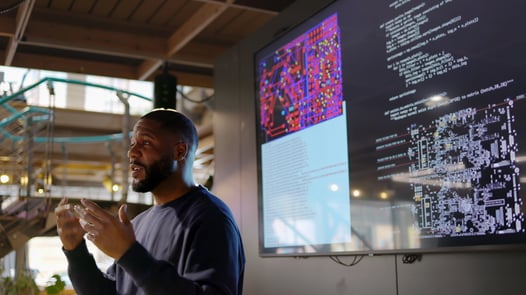Key Takeaways:
- ATS systems are not limited to managing applicants; they also support employer branding activities and streamline onboarding for new hires.
- A candidate-driven ATS, with features like easy application, engaging branding content, and a streamlined application process, enhances the overall candidate experience.
- Compatibility and integration of ATS with other recruitment tech stack platforms are essential for improving the efficiency of recruitment activities.
It’s been decades since organizations first began using the applicant tracking system (ATS) to automate key functions of the recruitment process. Whether employers make dozens or thousands of hires every year, the ATS has become an invaluable tool for helping talent acquisition teams track, evaluate, and move applicants through the candidate journey. With continued advances in technology, including an expanded role for AI, there is even greater potential for integrated ATS platforms to help organizations improve the candidate experience and reach their hiring goals of today and tomorrow.
The Evolution of the Modern ATS
Despite being heavily dependent on manual data entry, early applicant tracking systems paved the way for organizations to adopt modern employee recruitment strategies. ATS platforms have not only helped recruiters keep track of large amounts of applicants and resumes, but they have also made it easier to create job requisitions and post job ads. Now, recruitment teams use the cloud-based ATS as the record system for recruitment activities and integrate it with other platforms to make the hiring process more productive for candidates and recruiters. For this reason, it’s not surprising that 66% of large companies and nearly 99% of the Fortune 500 use an ATS platform.
The ATS is not only a well-integrated tool for helping organizations manage applicants; it also enables innovative employer branding activities and ensures a smoother onboarding after hire.
Here are two key integrations that help to position the ATS as a must-have technology for helping organizations reach their hiring goals:

Human Capital Management (HCM) System
When the ATS integrates with the HCM system, HR functions such as payroll, compensation, and benefits become more seamless as individuals move from being applicants to being employees. Information from the ATS flows directly into the HCM, eliminating the need to re-enter key candidate data. As a result, recruitment and HR teams save time, and new hires enjoy a more streamlined onboarding experience. And with better onboarding comes the increased likelihood that a filled position stays filled. One study found that organizations with a robust onboarding process enjoyed an 82% increase in new hire retention.
Candidate Relationship Management (CRM) System
Recruitment today requires not just managing and tracking applications and resumes, but also engaging and nurturing candidates whether they are in the awareness stage, are considering applying, or have applied and want to know more. By integrating the ATS with the CRM system, organizations can build engaged talent pipelines for specific roles and geographies. Talent acquisition teams can undertake all of the following activities when working with well-integrated ATS and CRM systems:
- Use creative assets such as videos to provide candidates with an inspiring view of the employee experience and company culture.
- Segment recruitment messaging to passive and active candidates at various stages of the applicant journey.
- Ensure timely communication with talent communities about new opportunities and more information about the employee value proposition (EVP)
Tip: Getting the messaging right is critical to keep both active and passive candidates engaged. With a compelling EVP, organizations can find greater success in nurturing stronger relationships with candidates.
Tips for Leveraging the ATS for the Future
While the ATS makes the recruitment process more productive, it can do so much more than automate workflows and boost efficiency. In fact, candidates stand to gain just as much from a well-integrated ATS as recruitment teams. In today’s competitive job market, the right ATS integration can help organizations deliver an experience that keeps candidates engaged and excited about sharing their experiences with others.
Here are three ways organizations can use their ATS to deliver an experience that attracts and engages high-quality candidates:

1. Use a Candidate-Driven ATS
Investing in the candidate experience is one of the most valuable actions organizations can take to support their branding and hiring efforts. After all, a candidate’s first-hand experience with an organization says a lot about what they can expect as an employee. In a CareerBuilder survey, 78% of applicants said their overall candidate experience was an indicator of how the company values its people.
To provide a positive experience candidates will be eager to share with their network, a candidate-driven ATS is an excellent place to start. Unlike other ATS platforms that may be more recruiter-centric and geared toward activities like internal collaborations and posting jobs, a candidate-driven ATS is configured with candidate needs and expectations in mind. Key characteristics include:
- Easy apply capability
- Engaging branding content that builds excitement and provides an authentic view of company culture
- The ability to apply to multiple jobs or companies without having to create a new account each time
- A short application process candidates can complete using any mobile device
Tip: 72% of candidates will tell their network about a negative experience with a prospective employer. In concert with an ATS that provides a more streamlined application process, organizations should also adopt employer branding strategies that demonstrate a commitment to positive candidate and employee experiences.
2. Integrate Compatible Technologies with the ATS
When the ATS doesn’t integrate well with the other platforms in the recruitment tech stack, everyone – recruiters, candidates, and hiring managers – feel the pain. Candidates end up having to re-enter a lot of the same information into multiple systems, and communication with candidates doesn’t flow as easily as it should. However, by ensuring recruitment platforms are well-integrated, talent acquisition teams can streamline the process and deliver a better overall experience for candidates.
Organizations wanting to use well-integrated recruitment technologies should always consider how well those platforms serve applicants. For example, talent acquisition teams should assess how well the ATS and its integrations provide the speed and efficiency today’s candidates look for when engaging with prospective employers. Depending on their existing setup, organizations may need to consider add-ons such as a recruitment video platform or a chatbot app. Another alternative is to consider whether an all-in-one recruitment technology solution is a more cost-effective way to attract and engage candidates in the long run.
Tip: One of the biggest drawbacks of using poorly-integrated recruitment platforms is inconsistent reporting and analytics. However, all-in-one recruitment analytics platform provides real-time visibility into the effectiveness of all recruitment activities, from sourcing to onboarding.

3. Incorporate AI into the Candidate Relationship Management Process
In recent years, AI-powered tools have helped to speed decision-making and automate processes more than ever before. In recruitment, AI acts as an extension of talent acquisition teams, helping to accelerate workflows and connect quality candidates to relevant job opportunities.
Given the complexities of AI technology and how quickly it evolves, it can be difficult for organizations to know how to use it and where it can add the most value in the recruitment process. A recent SHRM survey found that some organizations don’t use automation or AI to support HR activities because they don’t know which tools would best fit their needs. However, with the help of a recruitment partner skilled in helping organizations leverage technology for hiring success, recruitment teams can harness the power of AI to hire more competitively. For example, Recruitics’ Fusion AI talent engagement tools can take something as simple as a job title and a few key requirements to help recruiters create an entire job description in a matter of seconds. Among its other capabilities, the solution also leverages AI to automatically screen, filter, and move qualified candidates directly into the ATS.
Technology Solutions to Address the Recruitment Challenges of Today and Tomorrow
The right technology gives recruitment teams the support they need to compete effectively for talent, whether they need to uncover passive talent in challenging geographies or boost applicant quantity in a high-volume hiring scenario. As the core recruitment technology from which so many activities flow, the ATS is an excellent tool for helping organizations engage candidates more effectively and provide positive experiences that drive higher applicant conversions.
With new advances in AI and automation, organizations will continue to have opportunities to leverage the ATS to meet their recruitment goals now and in the future. As always, the team at Recruitics is here to help organizations leverage the latest advances in recruitment technology and achieve a higher recruitment ROI.


-2.png?width=520&height=294&name=Untitled%20design%20(36)-2.png)
